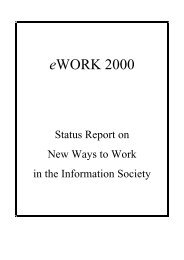Proceedings of 8th European Assembly on telework (Telework2001)
Proceedings of 8th European Assembly on telework (Telework2001)
Proceedings of 8th European Assembly on telework (Telework2001)
You also want an ePaper? Increase the reach of your titles
YUMPU automatically turns print PDFs into web optimized ePapers that Google loves.
189Claussen 2001) , the few bigger <strong>on</strong>es – such as Nordvestforum (Hanssen Bauer 2001) with about50 owner enterprises employing approximately 10 000 people – generally tend to form sub groupswhen running specific development projects. These limitati<strong>on</strong>s notwithstanding they still posechallenges <str<strong>on</strong>g>of</str<strong>on</strong>g> organisati<strong>on</strong> and a substantial number <str<strong>on</strong>g>of</str<strong>on</strong>g> new actors with legitimacy to organisehave actually appeared over the recent years. Interesting to note is also that practically all thelarger networks have emerged up<strong>on</strong> private initiatives rather than public and have received verylittle public support. What is lacking in mass in each network, is, however, made up in number <str<strong>on</strong>g>of</str<strong>on</strong>g>networks.The public support apparatus faces, in this kind <str<strong>on</strong>g>of</str<strong>on</strong>g> terrain, the challenge <str<strong>on</strong>g>of</str<strong>on</strong>g> having to deal –even within each regi<strong>on</strong> – with a substantial number <str<strong>on</strong>g>of</str<strong>on</strong>g> networks, each showing its own specialcharacteristics. Each initiative poses its own demands in terms <str<strong>on</strong>g>of</str<strong>on</strong>g> support and services. To meetthese demands the support apparatus has to differentiate and c<strong>on</strong>textualise itself but it still needsto keep itself together as “<strong>on</strong>e apparatus”. The support apparatus can no l<strong>on</strong>ger perform its tasksthrough giving out m<strong>on</strong>ey to pre-specified projects or implementing <strong>on</strong>e single strategy but hasto undertake much more differentiated tasks. The support apparatus c<strong>on</strong>sists, furthermore, not<strong>on</strong>ly <str<strong>on</strong>g>of</str<strong>on</strong>g> <strong>on</strong>e organisati<strong>on</strong> but <str<strong>on</strong>g>of</str<strong>on</strong>g> several: some state-level, some regi<strong>on</strong>al, some local. They needto co-ordinate their efforts, giving rise to a new set <str<strong>on</strong>g>of</str<strong>on</strong>g> complex tasks in “the terrain betweenorganisati<strong>on</strong>s”.Programs like “Enterprise Development 2000” and “Value Creati<strong>on</strong> 2010” are not the <strong>on</strong>ly networkoperators. Rather, they are <strong>on</strong>e type <str<strong>on</strong>g>of</str<strong>on</strong>g> initiative in a field with a growing number <str<strong>on</strong>g>of</str<strong>on</strong>g> initiatives.However, programs with research involvement have the potential <str<strong>on</strong>g>of</str<strong>on</strong>g> filling some special functi<strong>on</strong>s,in particular the functi<strong>on</strong> <str<strong>on</strong>g>of</str<strong>on</strong>g> developing knowledge c<strong>on</strong>cerning network organisati<strong>on</strong>. In the sameway as “internal organisati<strong>on</strong>” has been a main theme also in terms <str<strong>on</strong>g>of</str<strong>on</strong>g> research since Max Weber,the shift to networking does not mean to renounce <strong>on</strong> reflecti<strong>on</strong>s and analyses. In network societythere occurs, however, a major shift in the platforms from which reflecti<strong>on</strong>s are taking place.Whereas Max Weber developed a research role based <strong>on</strong> distance from real events and practicalprocesses, and <strong>on</strong> the idea <str<strong>on</strong>g>of</str<strong>on</strong>g> identifying universal characteristics <str<strong>on</strong>g>of</str<strong>on</strong>g> organisati<strong>on</strong> (although with anumber <str<strong>on</strong>g>of</str<strong>on</strong>g> modificati<strong>on</strong>s as seen from his critique <str<strong>on</strong>g>of</str<strong>on</strong>g> the ec<strong>on</strong>omic historians Roscher and Knies(Weber 1976)), the noti<strong>on</strong> <str<strong>on</strong>g>of</str<strong>on</strong>g> network prohibits, in itself, this kind <str<strong>on</strong>g>of</str<strong>on</strong>g> research role. In the sameway as a network does, by definiti<strong>on</strong>, not lend itself to steering from <strong>on</strong>e single point it does notlend itself to understanding from <strong>on</strong>e single point either. Being a horiz<strong>on</strong>tal organisati<strong>on</strong> a networkmust respect the aut<strong>on</strong>omy <str<strong>on</strong>g>of</str<strong>on</strong>g> each member and aut<strong>on</strong>omy is not <strong>on</strong>ly the right to represent <strong>on</strong>eselfbut also the right to understand <strong>on</strong>eself. Ultimately, the insights in the hows and whys <str<strong>on</strong>g>of</str<strong>on</strong>g> eachnetwork participant has to rest with the participant. In a network c<strong>on</strong>text the task <str<strong>on</strong>g>of</str<strong>on</strong>g> researchis not to “understand the actors” but the network. The network is, furthermore, not <strong>on</strong>ly a kind<str<strong>on</strong>g>of</str<strong>on</strong>g> structure; it is, above all, a way <str<strong>on</strong>g>of</str<strong>on</strong>g> performing work and as such it is a process. Within theframework <str<strong>on</strong>g>of</str<strong>on</strong>g> a process the knowledge demands do not pertain to “who we are” but to “what wedo”: what acti<strong>on</strong> is, at each and every time, most suited to improve <strong>on</strong> the links between the actors,<strong>on</strong> their resp<strong>on</strong>siveness towards each other, <strong>on</strong> their ability to mix impulses to create new hybrids,and so <strong>on</strong>. There are few general answers to questi<strong>on</strong>s <str<strong>on</strong>g>of</str<strong>on</strong>g> this kind: in networking the questi<strong>on</strong>semerge all the time, in c<strong>on</strong>tinuously new forms and settings and are never given any ultimateanswer. Research has to be present within the network rather than observe from outside. Only bybeing an inside member is it possible for research to see and grasp the challenges as they emergeat each and every time and help create not <strong>on</strong>ly the right resp<strong>on</strong>se in some generalised form butthe resp<strong>on</strong>se that is right because <str<strong>on</strong>g>of</str<strong>on</strong>g> its c<strong>on</strong>text and timing. This is the kind <str<strong>on</strong>g>of</str<strong>on</strong>g> research role thatcan be seen emerging within the programs but also in many other c<strong>on</strong>texts, such as the c<strong>on</strong>text <str<strong>on</strong>g>of</str<strong>on</strong>g>








